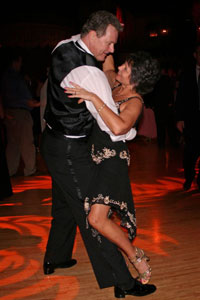Type: American Latin Dances (with Variants)
 Description
Description
Bolero is a slow, beautiful, expressive dance that is somewhat of a hybrid. It combines the dance patterns of Rumba with the rise and fall action of the Waltz. It is danced to music in 4/4 time, at a tempo slower than Rumba. Bolero is the slowest of all the American Style Rhythm dances.
It can be danced by either as a solo or a couple, and has many timings depending whether you are in Spain, Cuba, Mexico, or around the world.
Bolero is often called the “Cuban Dance of Love” and is believed to have evolved from Afro-Cuban and Spanish folk dances such as the Danzon, Beguine and Fandango. Originally it was danced in its classical form, to the constant beat of drums.
Danzon is the freer more spontaneous version of “Danza” which came to Cuba in the 18th century as “Contradanza” from Spain which came from “Contredanse” at the French Court in the 17th century. It has the typical instruments of Chamber music – violins etc with the addition of African drums. Danzon was danced by wealthy Cuban society where very small steps are taken, the women producing a subtle tilting of the hips by bending and straightening the knees.
First sung in Creole French, the Beguine developed as ballroom music on the islands of Guadeloupe and Martinique. The Martinique beguine dance is a slow close dance with a roll of the hips. The most famous interpretation of it was in 1938 with Artie Shaw’s rendition of Cole Porter’s “Begin the Beguine.”
Styles of Bolero
- Fandango: Fandango is a style of folk and flamenco music and dance. It arose as a dance of courtship in Andalusia in southern Spain early in the 18th century. Originally, the Fandango was always danced by only two persons who never touched each other with the body or the hand, only facing each other. This courtship dance is one of “The Chase,” basically boy sees girl, girl snubs boy, girl chases boy, and then runs away. The Fandango has been portrayed in many ballets as well. By the 19th century the Fandango was replaced by the Jota, Sevillana and Boléro.
- Cuban Boléro was derived from the old Spanish Boléro. The term “Boléro” stems from the Spanish verb “Volar” meaning “to fly,” exemplified in the elegant moves of the dancers. Cuban composer Pepe Sanchez composed the first known Cuban Bolero, entitled Tristeza (“Sadness”) in 1883. Cuban Boléro is a different dance than Spanish Boléro as the music and rhythms were changed by Cubans from 3/4 to 2/4 and then 4/4 time and is danced closer to a Rumba style. By the early 1900s, the immensely popular Bolero reached Mexico and Latin America, eventually gaining recognition in North America by the late 1920s.
- The American Bolero was made popular in the United States when French composer Maurice Ravel wrote his composition in 1928. Contemporary Boleros are a ballad style with slow tempos and sentimental lyrics usually with Spanish vocals and soft percussion.
History
 The credit of this dance goes to Sebastiano Carezo, in Spain, around 1780. Dancer Sebastiano Carezo is credited for inventing Spanish Boléro in 1780. Danced in 3/4 time, as a modification of the Fandango with the gracefulness retained and the objectionable parts omitted.
The credit of this dance goes to Sebastiano Carezo, in Spain, around 1780. Dancer Sebastiano Carezo is credited for inventing Spanish Boléro in 1780. Danced in 3/4 time, as a modification of the Fandango with the gracefulness retained and the objectionable parts omitted.
Cuban Bolero originated in Santiago de Cuba in the mid-19th century, but is quite different from the Spanish version. You can find more information about the history of Bolero here. After being in Cuba for some time, the dance traveled to Mexico and other areas in Latin America, and from there, the world.
Dance Characteristics
Bolero is a slow dance characterized by smooth, gliding movement, dramatic arm styling and a romantic feel. Bolero is a mixture of 3 dances: Tango (contra body movement), Waltz (body rise and fall) and Rumba (Cuban motion and slow Latin music).
There is also the concept of ‘drop and drift’ used on forward and back breaks, left-turning slip pivots and extended movements such as larger side steps. The Bolero frame is wider than a typical Rhythm frames and is a blend between the Smooth and Rhythm frame with the distance between the partners only a few inches apart or light body contact.
Videos
Video coming soon!
Musical Information
Time signature – 4/4
Tempo – 24-26 measures per minute
Timing – SQQ
Beat value 2-1-1
In Spain, it is danced in a 3/4 time. In Cuba, either 2/4 or 4/4 time, at a tempo slower than Rumba. The American version works is built of this Cuban theme, and here at Ballroom Dance Academy, we work on the 4/4 timing.
